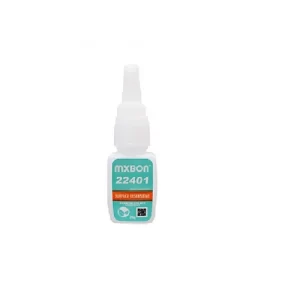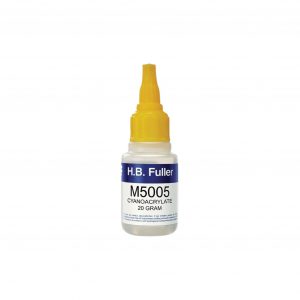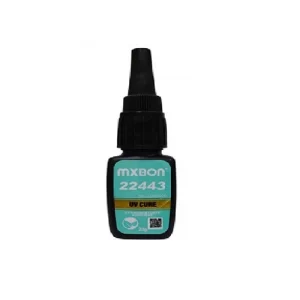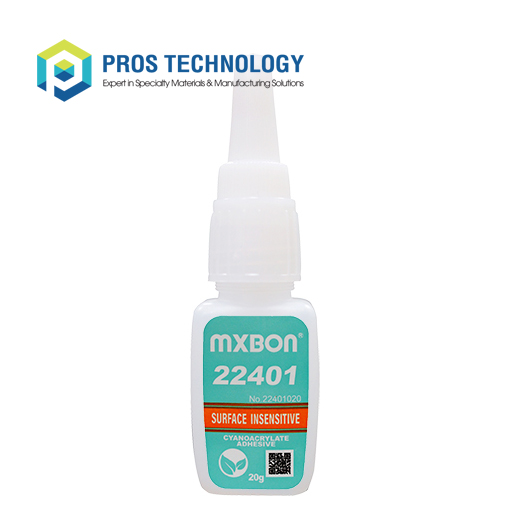The cause and the nature of blooming in CA adhesive
Cyanoacrylates (CAs) are commonly known as instant adhesive or super glue because of its high curing speed at room temperature. CAs cure very rapidly, by reacting to very small amounts of moisture on the surface of the components being bonded, achieve fixture strength in seconds and full cure in about 24 hours. In addition, they are also outstanding in their ability to adhere firmly to a wide range of substrates including plastic, glass, metal, or rubber,…That’s why CAs are used in almost every industry, from electrical and electronic to medical and automotive.
Beside the advantages of adhesion and curing speed, colorless and ability to reduce costs by increase throughput, conventional CA adhesives are prone to blooming.

Blooming is the phenomenon of a chalky white residue appearing on the surface around the bond using CA adhesive.
Blooming caused by unreacted cyanoacrylate monomers which evaporate and become airborne. Beacuse they are heavier than air, these molecules tend to fall back onto the surface of the part outside of the bondline in the form of white flakes. In great numbers, these flakes create a hazy or frosted appearance on the part.
.
Does blooming issue affect the bonding performance?
Although blooming has no negative effects on the strength and durability of the bond, this purely aesthetic problem is viewed as a detriment in applications where a clean bond line is critical, for example on cosmetic cases, medical equipment, electronic devices, pharmaceutical packages, appliances, automotive parts, and speakers.
How to prevent blooming issue of instant adhesive
1. Use low odor, low-blooming instant adhesive
These adhesives use cyanoacrylate monomers with higher molecular weights than those of traditional CAs, which make them less likely to become airborne than standard cyanoacrylate monomers, reducing blooming and chemical odors.
- Low odor low blooming
- For general purpose with low viscosity, transparent
- Fast setting for easy handling
- Excellent adhesion to most substrates, especially suited insensitive surface and low energy surface
- Withstand temperature up to 100°C
- Certified by ISO 10993-5, used in Medical Industry
.
- Low Bloom, Low Odor
- Ester Base: Ethoxyethyl
- Viscosity: 4±2 cps
- Color: Clear
- Set Time* (Metal/Rubber/Plastic): 15 – 5 – 10 s
- Strength PSI (Steel:Steel Tensile Shear): 2400
- Temperature Range: -65o to 180o F
- USP Class VI / ISO 10993-5 Certified.
2. Use flashcure or light cure CAs
These adhesives combine cyanoacrylate and light cure technology to cure tack-free in less than 5 seconds rather than the 30 seconds required by regular instant adhesives. This extremely rapid cure eliminates the possibility of blooming because the adhesive never has a chance to become airborne.
- Transparent, slight green color
- Rapid fixture
- Cure with UV light and/or moisture
- Gap filling capacity
- Certified ISO 10993-5, used in Medical Industry
- Viscosity: 150~300cps
.
3. Avoid large fillets
Fillets are areas along the bond line where adhesive squeezes out or reaches just beyond the edge of the substrate. This provides an ideal opportunity for blooming to occur, as the adhesive is completely exposed to the open air. By keeping the adhesive within the bond line and minimizing substrate-level exposure, less adhesive will be available to become airborne and migrate beyond the bond line.

One way to precisely control the bondline is to automatically or semi-automatically dispense the adhesive. For instance, for a semi-automated and precise dispensing technique, you can combine a pressure pot or reservoir with a suitable diaphragm dispensing valve. Mounting this equipment on a robot to fully automate will result in a methodology requiring very little operator intervention
Dispensing Solution for Cyanoacrylate Adhesive
.
4. Increase air flow
Avoid assembling parts and immediately placing them in an airtight environment such as a bag or shipping container. Cross ventilation helps carry airborne CA molecules away from the bond area, minimizing the number of molecules available to fall back to the bond line area.
5. Use accelerators
The faster the adhesive cures, the lower the chance there will be unreacted cyanoacrylate monomers that become airborne. Adding an accelerator to speed the rate of cure reduces the chances of frosting. But cure speed must be carefully managed—the heat generated by too fast a cure may result in a phenomenon similar to frosting where the rapid exothermic reaction drives off unreacted monomer.
- Acetone based
- Speeds the cure of cyanoacrylates
- Assists in gap-filling and fillet applications
- Can be pre- or post-applied.
6. Avoid acidic surfaces
Acidic surfaces slow down the cyanoacrylate cure mechanism and keep the adhesive uncured longer. When bonding acidic surfaces, rinse to reduce acidity or choose an adhesive or accelerator designed to work under these conditions such as a surface insensitive instant adhesive.
7. Avoid extremes in relative humidity
If relative humidity is too low, the adhesive will take longer to cure. If it’s too high, the curing reaction may occur too quickly and exothermic reaction may allow blooming to occur. Relative humidity of 40 to 80% is recommended for cyanoacrylate cure.
8. Avoid extremes in temperature
Elevated temperatures promote the vapor pressure or volatility of the CA monomer, leading to higher blooming vulnerability. Conversely, lower temperatures slow the reaction mechanism, causing prolonged cure time and opportunity for the CA monomer to become airborne. A temperature controlled environment as close to 70°F is ideal.
9. Avoid the use of old material
Old product does not cure as quickly as fresh material. And when cure is slowed, there is more opportunity for adhesive particles to become airborne and for blooming to occur.
Find your suitable instant adhesive here.
For more information, contact us:







